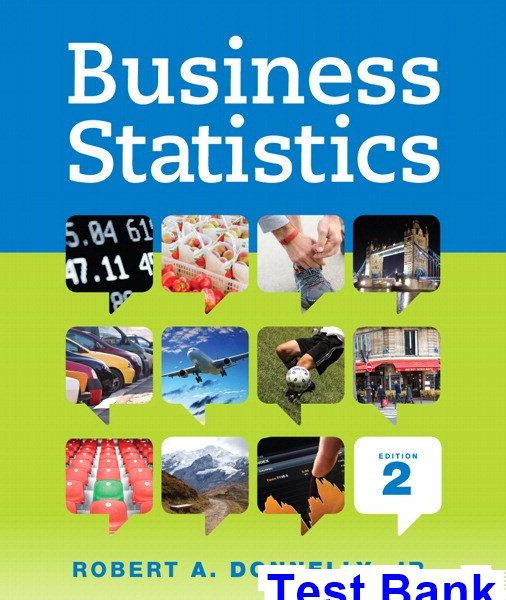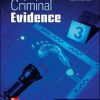Business Statistics 2nd Edition Donnelly Test Bank
$35.00 Original price was: $35.00.$26.50Current price is: $26.50.
Business Statistics 2nd Edition Donnelly Test Bank
Instant download Business Statistics 2nd Edition Donnelly Test Bank pdf docx epub after payment.

Product details:
- ISBN-10 : 0321930673
- ISBN-13 : 978-0321930675
- Author: Robert Donnelly
Robert Donnelly’s Business Statistics eliminates the intimidation factor from learning statistics for business. The Second Edition maintains Donnelly’s successful straightforward, conversational approach that explains each concept and why it is important directly to students. Through an abundance of comments that clarify specific topics, a variety of applications, and Your Turn practice throughout each chapter, students see business statistics in action-both in the classroom and in the world around them.
Table of contents:
Normal 0 false false false MicrosoftInternetExplorer4 Preface
Acknowledgments
Dear Students
1. An Introduction to Business Statistics
1.1 Business Statistics and Their Uses
1.2 Data
1.3 Descriptive and Inferential Statistics
1.4 Ethics and Statistics—It’s a Dangerous World of Data Out There
2. Displaying Descriptive Statistics
2.1 The Role Technology Plays in Statistics
2.2 Displaying Quantitative Data
2.3 Displaying Qualitative Data
2.4 Contingency Tables
2.5 Stem and Leaf Display
2.6 Scatter Plots
3. Calculating Descriptive Statistics
3.1 Measures of Central Tendency
3.2 Measures of Variability
3.3 Using the Mean and Standard Deviation Together
3.4 Working with Grouped Data
3.5 Measures of Relative Position
3.6 Measures of Association Between Two Variables
4. Introduction to Probabilities
4.1 An Introduction to Probabilities
4.2 Probability Rules for More Than One Event
4.3 Counting Principles
5. Discrete Probability Distributions
5.1 Introduction to Discrete Probability Distributions
5.2 Binomial Distributions
5.3 Poisson Distributions
5.4 The Hypergeometric Distribution
6. Continuous Probability Distributions
6.1 Continuous Random Variables
6.2 Normal Probability Distributions
6.3 Exponential Probability Distributions
6.4 Uniform Probability Distributions
7. Sampling and Sampling Distributions
7.1 Why Sample?
7.2 Types of Sampling
7.3 Sampling and Nonsampling Errors
7.4 The Central Limit Theorem
7.5 The Sampling Distribution of the Proportion
8. Confidence Intervals
8.1 Point Estimates
8.2 Calculating Confidence Intervals for the Mean when the Standard Deviation (σ) of a Population Is Known
8.3 Calculating Confidence Intervals for the Mean when the Standard Deviation (σ) of a Population Is Unknown
8.4 Calculating Confidence Intervals for Proportions
8.5 Determining the Sample Size
8.6 Calculating Confidence Intervals for Finite Populations
9. Hypothesis Testing for a Single Population
9.1 An Introduction to Hypothesis Testing
9.2 Hypothesis Testing for the Population Mean When σ Is Known
9.3 Hypothesis Testing for the Population Mean when σ Is Unknown
9.4 Hypothesis Testing for the Proportion of a Population
9.5 Type II Errors
10. Hypothesis Tests Comparing Two Populations
10.1 Comparing Two Population Means with
10.2 Comparing Two Population Means with
10.3 Hypothesis Testing With Dependent Samples
10.4 Comparing Two Population Proportions with Independent Samples
11. Analysis of Variance (ANOVA) Procedures
11.1 One-Way ANOVA: Examining the Effect a Single Factor Has on the Means of Populations
11.2 Randomized Block ANOVA: Examining the Effects of a Single Factor by Blocking a Second Factor
11.3 Two-Way ANOVA: Examining the Effects Two Factors Have on the Means of Populations
12. Chi-Square Tests
12.1 Comparing Two or More Population Proportions
12.2 Determining If Observed Frequencies Follow a Known Probability Distribution
12.3 Testing the Independence of Two Variables
13. Hypothesis Tests for the Population Variance
13.1 Testing the Variance of a Single Population
13.2 Comparing the Variances of Two Populations
14. Correlation and Simple Linear Regression
14.1 Dependent and Independent Variables
14.2 Correlation Analysis
14.3 Simple Linear Regression Analysis
14.4 Using a Regression to Make a Prediction
14.5 Testing the Significance of the Slope of the Regression Equation
14.6 Assumptions for Regression Analysis
14.7 A Simple Regression Example with a Negative Correlation
14.8 Some Final (but Very Important) Thoughts
15. Multiple Regression and Model Building
15.1 Developing the Multiple Regression Model
15.2 Explaining the Variation of the Dependent Variable
15.3 Inferences about the Independent Variables
15.4 Using Qualitative Independent Variables
15.5 Model Building
16. Forecasting
16.1 Introduction to Forecasting
16.2 Smoothing Forecasting Methods
16.3 Forecasting with Regression Analysis
16.4 Forecasting with Seasonality
17. Decision Analysis
17.1 Introduction to Decision Analysis
17.2 Constructing a Decision Table
17.3 Decision Making Under Uncertainty
17.4 Decision Making Under Risk
17.5 Decision Making Using Decision Trees
17.6 Using Bayes’ Theorem to Calculate Posterior Probabilities
18. Nonparametric Statistics
18.1 Introduction to Nonparametric Statistics
18.2 The Sign Test
18.3 The Wilcoxon Rank-Sum Test for Two Independent Samples
18.4 The Wilcoxon Signed-Rank Test for Two Dependent Samples
18.5 The Kruskal-Wallis One-Way ANOVA
18.6 The Spearman Rank-Order Correlation Coefficient
Appendix A
Table 1 Binomial Probabilities
Table 2 Poisson Probabilities
Table 3 Cumulative Probabilities for the Standard Normal Distribution
Table 4 Cumulative Probabilities for the Standard Normal Distribution
Table 5 Student’s t-distribution
Table 6 F-distribution
Table 7 Critical Values of the Studentized Range, Q
Table 8 Chi–Square Distribution
Table 9 Critical Values for the Durbin-Watson Statistic
Appendix B: Answers to Selected Even-Numbered Problems
Index of Applications
Index
People also search:
Business Statistics 2nd Edition
Business Statistics
Business Statistics 2nd Edition pdf
business statistics for contemporary decision making
how statistics helps in business
what is statistics in business statistics











